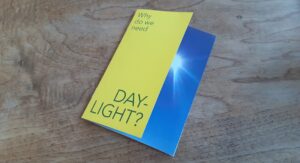Daylight Ambassadors

Health-promoting properties of daylight have long been known and have been applied successfully in light therapy. As early as the 1940s Fritz Hollwich has been researching the influence of light on the regulation of metabolism. He was probably the first who discovered that the stress hormone level drops when ordinary fluorescent tubes (with a band spectrum) are replaced by light with a broader spectrum and a better colour rendering – closer to natural daylight. In a recent controlled laboratory study (Cajochen et al., LRT 2019) on light quality and its effect on people, more positive effects of a daylight spectrum artificial light on visual comfort, mood and sleep were discovered. Although it is obvious that we have to expose ourselves to sufficient daylight, this is often neglected in building design, probably because it is not easy to estimate a scientifically proven precise amount and duration of daylight exposure. So far, circulating illuminance values are based on very approximate scientific data. The new European standard EN 17037 “Daylight in Buildings” with recommendations for daylight supply and daylight quality shows how relevant this topic is. It should therefore be promoted to all stake holders in the field.
We need to raise awareness about the need of more research on daylight. We have to make scientists, professionals, decision-makers and the public more aware of the so far proven benefits of daylight. An ambitious goal would be to place a daylight specific call at a future EU funding programme for research.
Lead
Dr Oliver Stefani, Lucerne University of Applied Sciences and Art, Switzerland
Materials developped
 DLA flyer “Why do we need Daylight?“
DLA flyer “Why do we need Daylight?“